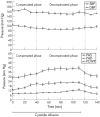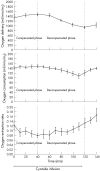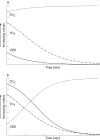Clarification of cyanide's effect on oxygen transport characteristics in a canine model
- PMID: 17351216
- PMCID: PMC2816935
- DOI: 10.1136/emj.2006.038927
Clarification of cyanide's effect on oxygen transport characteristics in a canine model
Abstract
Objective: To clarify the cardiovascular mechanisms of cyanide poisoning by evaluating oxygen transport characteristics using a canine model.
Methods: A prospective controlled experiment was performed at a hospital-based animal laboratory. Five male beagle (17 (2) kg) dogs were anesthetised with alpha-chloralose, paralysed with pancuronium bromide and mechanically ventilated. Potassium cyanide was infused at 0.045 mg/kg/min for 110 min. Heart rate, blood pressure, cardiac output, oxygen delivery (DO2), oxygen consumption (VO2) and oxygen extraction ratio (OER) were measured every 10 min for 140 min. DO2 was measured by an indirect calorimeter.
Results: Cyanide and lactate levels peaked at 1.52 (0.25) mg/l and 9.1 (1.5) mmol/l, respectively. Systolic blood pressure remained relatively constant whereas diastolic blood pressure decreased by 19%. Cardiac output, heart rate and DO2 increased to a maximum of 6%, 10% and 10%, respectively, at 40 min, after which they declined to a low of 32%, 28% and 30% below baseline, respectively. Stroke volume remained constant. Oxygen consumption initially increased by 5%, then decreased to 24% below baseline. The OER initially declined to 35% below baseline, then increased throughout the rest of the study.
Conclusion: Cyanide poisoning in the canine model showed two phases of injury. The first (compensated) phase had a mechanism consistent with a traditional global oxygen consumption defect. The second (decompensated) phase had a mechanism consistent with heart failure. This heart failure was due to bradycardia. These data suggest chronotropy as an avenue of further study in the temporary treatment of cyanide poisoning.
Conflict of interest statement
Competing interests: None declared.
References
-
- Jones J, McMullen M J, Dougherty J. Toxic smoke inhalation: cyanide poisoning in fire victims. Am J Emerg Med 19875317–321. - PubMed
-
- Thompson R L, Manders W W, Cowan W R. Postmortem findings of the victims of the Jonestown tragedy. J Forensic Sci 198732433–443. - PubMed
-
- Caravati E M, Litovitz T L. Pediatric cyanide intoxication and death from an acetonitrile‐containing cosmetic. JAMA 19882603470–3473. - PubMed
MeSH terms
Substances
LinkOut - more resources
Full Text Sources





